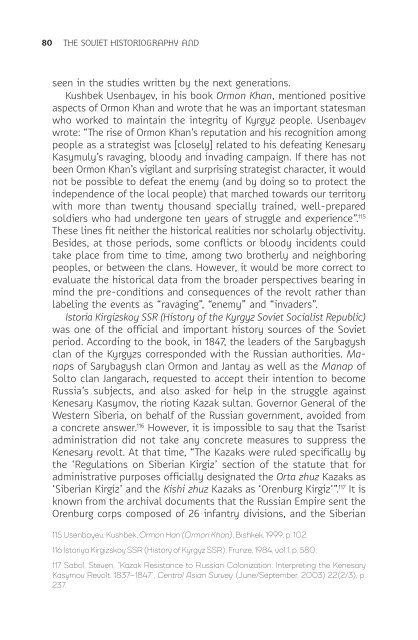THE SOVIET HISTORIOGRAPHY AND THE QUESTION OF KAZAKHSTAN’S HISTORY
SOVYET-TARIH-YAZICILIGI-ENG
SOVYET-TARIH-YAZICILIGI-ENG
Create successful ePaper yourself
Turn your PDF publications into a flip-book with our unique Google optimized e-Paper software.
80<br />
<strong>THE</strong> <strong>SOVIET</strong> <strong>HISTORIOGRAPHY</strong> <strong>AND</strong><br />
seen in the studies written by the next generations.<br />
Kushbek Usenbayev, in his book Ormon Khan, mentioned positive<br />
aspects of Ormon Khan and wrote that he was an important statesman<br />
who worked to maintain the integrity of Kyrgyz people. Usenbayev<br />
wrote: “The rise of Ormon Khan’s reputation and his recognition among<br />
people as a strategist was [closely] related to his defeating Kenesary<br />
Kasymuly’s ravaging, bloody and invading campaign. If there has not<br />
been Ormon Khan’s vigilant and surprising strategist character, it would<br />
not be possible to defeat the enemy (and by doing so to protect the<br />
independence of the local people) that marched towards our territory<br />
with more than twenty thousand specially trained, well-prepared<br />
soldiers who had undergone ten years of struggle and experience”. 115<br />
These lines fit neither the historical realities nor scholarly objectivity.<br />
Besides, at those periods, some conflicts or bloody incidents could<br />
take place from time to time, among two brotherly and neighboring<br />
peoples, or between the clans. However, it would be more correct to<br />
evaluate the historical data from the broader perspectives bearing in<br />
mind the pre-conditions and consequences of the revolt rather than<br />
labeling the events as “ravaging”, “enemy” and “invaders”.<br />
Istoria Kirgizskoy SSR (History of the Kyrgyz Soviet Socialist Republic)<br />
was one of the official and important history sources of the Soviet<br />
period. According to the book, in 1847, the leaders of the Sarybagysh<br />
clan of the Kyrgyzs corresponded with the Russian authorities. Manaps<br />
of Sarybagysh clan Ormon and Jantay as well as the Manap of<br />
Solto clan Jangarach, requested to accept their intention to become<br />
Russia’s subjects, and also asked for help in the struggle against<br />
Kenesary Kasymov, the rioting Kazak sultan. Governor General of the<br />
Western Siberia, on behalf of the Russian government, avoided from<br />
a concrete answer. 116 However, it is impossible to say that the Tsarist<br />
administration did not take any concrete measures to suppress the<br />
Kenesary revolt. At that time, “The Kazaks were ruled specifically by<br />
the ‘Regulations on Siberian Kirgiz’ section of the statute that for<br />
administrative purposes officially designated the Orta zhuz Kazaks as<br />
‘Siberian Kirgiz’ and the Kishi zhuz Kazaks as ‘Orenburg Kirgiz’”. 117 It is<br />
known from the archival documents that the Russian Empire sent the<br />
Orenburg corps composed of 26 infantry divisions, and the Siberian<br />
115 Usenbayev, Kushbek, Ormon Han (Ormon Khan), Bishkek, 1999, p. 102.<br />
116 İstoriya Kirgizskoy SSR (History of Kyrgyz SSR). Frunze, 1984, vol.1, p. 580.<br />
117 Sabol, Steven, “Kazak Resistance to Russian Colonization: Interpreting the Kenesary<br />
Kasymov Revolt, 1837–1847”, Central Asian Survey (June/September, 2003) 22(2/3), p.<br />
237.



